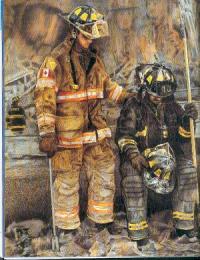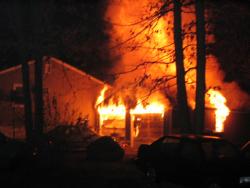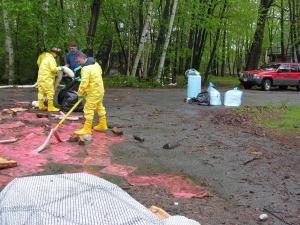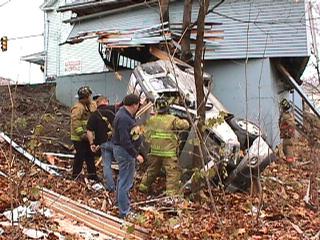Training Division
Welcome to the Merrimack Fire and Rescue Department Training page. In keeping with the departments overall vision, the training division is committed to providing the best and most comprehensive training available to all Merrimack Fire and Rescue personnel thereby assuring the citizens of Merrimack that they will receive the very best customer service available in their time of need.
 Very few professions can be considered as dynamic as the fire service; in the past twenty years we have seen such a remarkable change in the overall approach to firefighting that our predecessors would hardly recognize it. While our profession has seen a decline in building fires during this time period, we have also seen a dramatic rise in responses to incidents such hazardous materials releases, motor vehicle accidents, technical rescues, industrial accidents as well as a dramatic rise in emergency medical calls. While most sectors of our society have worked to make their products safer and more user friendly, this has not always translated to safety in the fire service. Building practices best speak to that point in that houses and commercial buildings today are not built to withstand the rigors of fire and this has contributed too many firefighter deaths and injuries annually. Our post September 11th world has forced the fire service as a whole to reexamine how it responds to routine incidents, and to be wary of possible terrorist attacks at any place or any time. Never before has the danger of walking into a situation that may involve explosives or biological agents been as prevalent as it is in today’s society. This includes illegal clandestine drug labs that have made their way eastward in the last decade, and are now in every sector of our society and pose a tremendous risk to today’s emergency personnel.
Very few professions can be considered as dynamic as the fire service; in the past twenty years we have seen such a remarkable change in the overall approach to firefighting that our predecessors would hardly recognize it. While our profession has seen a decline in building fires during this time period, we have also seen a dramatic rise in responses to incidents such hazardous materials releases, motor vehicle accidents, technical rescues, industrial accidents as well as a dramatic rise in emergency medical calls. While most sectors of our society have worked to make their products safer and more user friendly, this has not always translated to safety in the fire service. Building practices best speak to that point in that houses and commercial buildings today are not built to withstand the rigors of fire and this has contributed too many firefighter deaths and injuries annually. Our post September 11th world has forced the fire service as a whole to reexamine how it responds to routine incidents, and to be wary of possible terrorist attacks at any place or any time. Never before has the danger of walking into a situation that may involve explosives or biological agents been as prevalent as it is in today’s society. This includes illegal clandestine drug labs that have made their way eastward in the last decade, and are now in every sector of our society and pose a tremendous risk to today’s emergency personnel.
All these possible scenarios have led to an unprecedented commitment to training by Merrimack Fire Rescue’s talented and dedicated members. Maintaining proficiency in our most common types of calls requires members to train in up to date techniques for emergency medical response as well those involving building fires of all types.  Merrimack Fire and Rescue is comprised of emergency medical technicians for basic level responses, emergency medical technician intermediates, a more advanced training level, and emergency medical technician paramedics. Both emergency medical technicians and intermediates work hand in hand with Merrimack Fire Rescue paramedics to provide a fire based ambulance service that is second to none. All of our firefighters and EMS personnel need to have better than seventy two hours of continuing education including a recertification class every two years, in addition, they also need keep current and certified in the latest cardiopulmonary resuscitation and cardiac defibrillation techniques.
Merrimack Fire and Rescue is comprised of emergency medical technicians for basic level responses, emergency medical technician intermediates, a more advanced training level, and emergency medical technician paramedics. Both emergency medical technicians and intermediates work hand in hand with Merrimack Fire Rescue paramedics to provide a fire based ambulance service that is second to none. All of our firefighters and EMS personnel need to have better than seventy two hours of continuing education including a recertification class every two years, in addition, they also need keep current and certified in the latest cardiopulmonary resuscitation and cardiac defibrillation techniques.
Firefighters also need to stay abreast of building construction deficiencies and clues to the potential of an early and deadly building collapse. All four of Merrimack’s shifts and the call force spent over one hundred and sixteen hours late in 2007 training on large area search and firefighter rescue techniques; this is termed Rapid Intervention Team training. This training is necessary to rescue firefighters who may have become victims because of building collapse, exhaustion or disorientation. While much of Rapid Intervention Training involves basic techniques and old fashion hard work, in does also incorporate the state of the art technology of thermal imaging cameras.
While maintaining basic skills is a top priority for Merrimack’s firefighters, so is training for high risk low frequency events such as a hazardous materials spills, confined space rescues, multiple motor vehicle extrications and terrorist bombings. Much of the first part of 2008 has been spent training with Merrimack Fire Rescue state of the art heavy rescue, particularly its AMKUS Ultimate vehicle extrication equipment, the only one of its kind in all of New England.  Due to the generosity of Majestic Motors, firefighters were able to perform many different types of extrication techniques based on a number of different scenarios involving motor vehicle accidents. Firefighters are now moving on to maintaining their skills in emergency response to hazardous materials incidents. This training involves being able to recognize multiple types of hazards, including the possibility of a terrorist incidents. Due to the higher volume of hazardous materials traveling over our roadways on a daily basis, the likelihood of an event involving a hazardous material, whether in transit, or at a fixed facility, is not likely to diminish any time soon. As we move through the rest of the year, firefighters will receive training in technical rescue skills and more specifically confined space rescue.
Due to the generosity of Majestic Motors, firefighters were able to perform many different types of extrication techniques based on a number of different scenarios involving motor vehicle accidents. Firefighters are now moving on to maintaining their skills in emergency response to hazardous materials incidents. This training involves being able to recognize multiple types of hazards, including the possibility of a terrorist incidents. Due to the higher volume of hazardous materials traveling over our roadways on a daily basis, the likelihood of an event involving a hazardous material, whether in transit, or at a fixed facility, is not likely to diminish any time soon. As we move through the rest of the year, firefighters will receive training in technical rescue skills and more specifically confined space rescue.
The manner in which fire departments manage emergency incidents has changed significantly in the wake of September 11, now all agencies nationwide are required to follow the National Incident Management system.  The National Incident Management system, NIMs, is designed to provide responders from all over the country the tools to integrate with any other agency that may be part of a response for a seamless transition. NIMs place a focus on common terminology and definitions so that all parties involved are speaking the same language.
The National Incident Management system, NIMs, is designed to provide responders from all over the country the tools to integrate with any other agency that may be part of a response for a seamless transition. NIMs place a focus on common terminology and definitions so that all parties involved are speaking the same language.
As we move forward, our focus is on maintaining those skills necessary for our every day incidents, as well as preparing for those high risk low frequency events. While our training must focus on giving our firefighters the tools necessary for the here and now, we are also trying to stay ahead of the curve and train for the future as well, cultivating the future leaders of the fire service will become and remain a priority ensure quality service well into the future. While we understand the future is uncertain, our commitment to training and maintaining an excellent fire and rescue team is certain.

